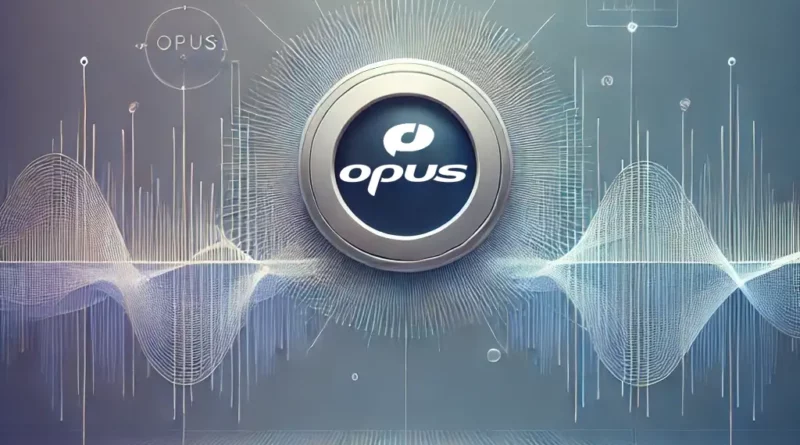What is the Opus Codec and Why is it Important?
In the ever-evolving world of digital communication, codecs play a critical role in how we transmit and receive audio over the internet. Among the various codecs available, Opus has emerged as a standout for its flexibility, high-quality performance, and broad adoption across a range of applications. This article explores what the Opus codec is, its features, and why it has become a pivotal tool in modern telecommunications, streaming, and real-time communication.

What is Opus?
Opus is an open, royalty-free audio codec that was standardized by the Internet Engineering Task Force (IETF) in 2012 with RFC 6716. It is designed to be highly versatile, offering superior performance across a wide range of audio applications, from low-bitrate voice communication to high-fidelity music streaming.
Opus combines two different types of audio compression algorithms: the Silk codec (originally developed by Skype for speech) and the CELT codec (Constrained Energy Lapped Transform, designed for low-latency high-quality audio). By integrating these technologies, Opus delivers a hybrid codec capable of adapting to various audio demands with low latency and excellent quality.
Key Features of Opus:
- Wide Bitrate Range: Opus supports bitrates from as low as 6 kbps to 510 kbps, making it suitable for both low-bandwidth voice calls and high-fidelity music streams.
- Dynamic Adaptive Bitrate: Opus can adjust bitrate dynamically in real time based on network conditions, ensuring a consistent quality of service even in variable network environments.
- Sampling Rates: It supports a wide range of sampling rates, from 8 kHz (narrowband) to 48 kHz (fullband), allowing for both narrowband speech and fullband stereo music.
- Low Latency: Designed for real-time applications, Opus offers extremely low latency (as low as 5 ms) while maintaining high audio quality. This makes it ideal for VoIP (Voice over IP), video conferencing, and interactive applications.
- Support for Stereo and Surround Sound: Opus is not just limited to mono and stereo audio but also supports up to 255 channels for more complex audio requirements, such as surround sound in gaming or movie streaming.
- Robustness: The codec includes built-in error resilience to handle packet loss, a common issue in real-time audio transmission over the internet.
Why is Opus Important?
Opus is widely regarded as one of the most versatile and high-performing audio codecs in use today. Several factors contribute to its importance:
1. Broad Application Support
Opus has become a standard in a wide range of real-time and non-real-time applications. It is supported by many popular platforms, including:
- WebRTC (Web Real-Time Communication): As part of the WebRTC standard, Opus is integral to browser-based audio/video communication platforms like Google Meet, Zoom, and other VoIP applications. It allows seamless, high-quality audio even with limited bandwidth.
- Streaming Services: Opus is increasingly being adopted for streaming music and video. Services like YouTube, Tidal, and Spotify have integrated Opus to ensure high-quality sound while minimizing bandwidth usage.
- Gaming: The codec is popular in online gaming environments for in-game voice chat because of its low-latency characteristics, allowing for real-time communication with minimal lag.
- Broadcasting: Internet radio and podcasting services benefit from Opus due to its ability to handle speech and music at high quality, even under constrained bandwidth conditions.
2. Opus is Open and Royalty-Free
The fact that Opus is open-source and royalty-free is a huge advantage over many proprietary codecs. Developers can implement the codec without worrying about licensing fees, making it accessible for both commercial and non-commercial use. This has led to widespread adoption, including integration into browsers (such as Firefox and Chrome), mobile apps, and various hardware devices.
3. Flexibility in Network Conditions
Opus is designed to handle the unpredictable nature of internet communication, where network conditions may fluctuate rapidly. With its ability to adapt bitrate and quality in real-time, Opus ensures that audio remains intelligible and clear even during periods of high packet loss or bandwidth variability. This makes it a preferred codec for VoIP services and conferencing systems that require reliable communication under less-than-ideal network conditions.
4. High-Quality Speech and Music
Unlike many codecs that are optimized for either speech or music but not both, Opus excels in handling both types of audio. Its hybrid nature allows it to switch seamlessly between speech-oriented (using the Silk layer) and music-oriented (using the CELT layer) compression modes, ensuring optimal performance for various types of content. Whether you are listening to a podcast, joining a conference call, or streaming a concert, Opus can deliver the best possible audio experience.
5. Backed by Industry Leaders
Opus is supported by major players in the tech industry, including Mozilla, Google, Xiph.Org, and Microsoft, among others. This strong industry backing has ensured continued development, optimization, and widespread adoption of the codec.
Use Cases of Opus
- VoIP and Video Conferencing:
Opus is the go-to codec for real-time communication applications. Platforms like Skype, WhatsApp, and Zoom rely on Opus for crystal-clear voice and video calls. Its low latency and ability to adjust to network conditions make it ideal for these use cases. - WebRTC:
Opus is the default codec for audio in WebRTC, the framework used for peer-to-peer communication in web browsers. WebRTC-based applications such as Google Meet and Discord depend on Opus to deliver high-quality audio between participants without requiring additional plugins or software. - Streaming and Broadcast:
Streaming platforms benefit from Opus’ ability to compress high-quality audio efficiently. Music streaming services like Spotify and Tidal use Opus to reduce data usage while maintaining sound quality, making it a popular choice for bandwidth-conscious streaming. - Gaming:
With the rise of online multiplayer games, Opus has been widely adopted for in-game voice chat due to its low-latency properties, ensuring smooth, real-time communication between players. Popular titles like Fortnite and League of Legends use Opus for their voice chat features.
Conclusion
Opus has proven to be a game-changer in the realm of digital audio communication. Its flexibility, openness, and ability to deliver high-quality audio across a wide range of applications have cemented its importance in the modern technological landscape. From VoIP and video conferencing to streaming and gaming, Opus stands out as one of the most efficient, versatile, and reliable codecs available today. As the demand for real-time and high-quality audio communication grows, Opus is well-positioned to remain at the forefront of innovation in the audio codec space.
References:
- Valin, J.-M., Vos, K., & Terriberry, T. B. (2012). Definition of the Opus Audio Codec. IETF RFC 6716. Retrieved from https://tools.ietf.org/html/rfc6716.
- WebRTC. (n.d.). WebRTC Audio Codecs: Opus. Retrieved from https://webrtc.org.
- Xiph.Org. (n.d.). Opus Codec. Retrieved from https://opus-codec.org.
- Mozilla Developer Network. (n.d.). Opus: The Audio Codec for Interactive Applications. Retrieved from https://developer.mozilla.org.



